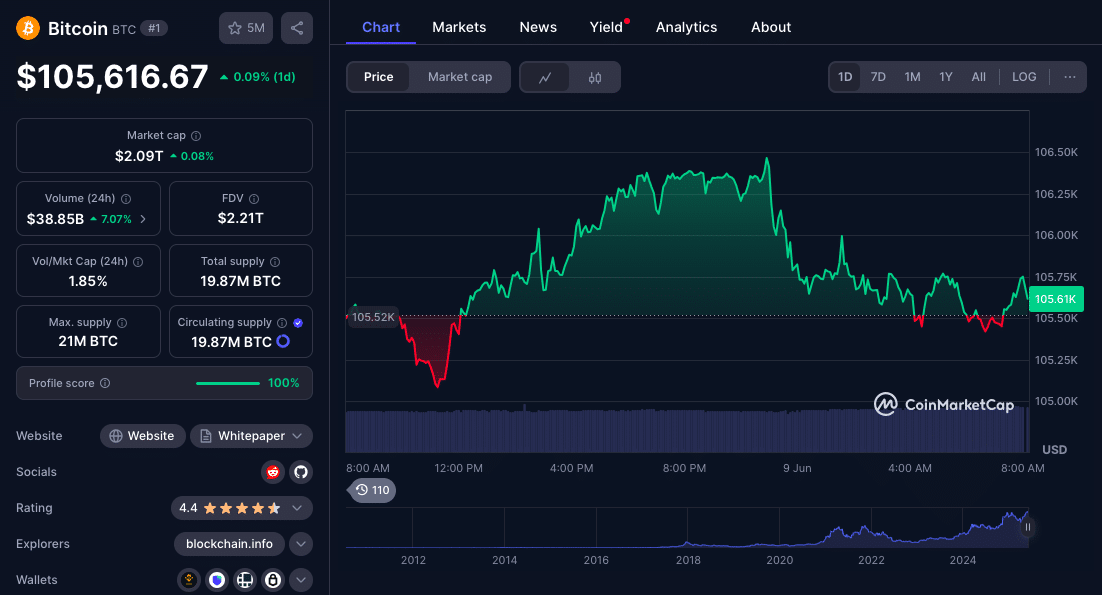Despite global equities getting a boost from US-China trade talks, Bitcoin has remained stagnant, garnering little to no change as of the time of this writing, stuck at $105,616. As Hong Kong’s Hang Seng index broke above 24,000 for the first time in months, the top cryptocurrency remained stuck in a holding pattern, stressing the growing divergence between traditional markets and digital assets.
- Crypto Stagnant as Stocks Celebrate Diplomatic Progress
- China Deflation Deepens as Tariffs Bite, Stimulus Looms
- US CPI in Focus as Traders Wait for Tariff Fallout
- Bitcoin’s Technicals Reflect Uncertainty
- Conclusion: Trade Talks Lift Stocks, But Crypto Waits
- FAQs
- Why isn’t BTC reacting to the Hang Seng rally?
- What does China’s deflation mean for crypto?
- How will the U.S. CPI report impact Bitcoin?
- What are the technical levels for Bitcoin?
- Glossary
Crypto Stagnant as Stocks Celebrate Diplomatic Progress
Based on available reports, Hong Kong’s Hang Seng index rose 1.3% as diplomatic talks between US and Chinese trade reps in London this week are expected to thaw tensions. The optimism lifted other Asian markets, with South Korea’s KOSPI and China’s Shanghai Composite up too. However, crypto was flatlined.
Bitcoin was stuck in a tight range around $105,650 after a doji candle on Sunday, a candlestick pattern that shows indecision in the market. According to TradingView data, the price action came with declining on-chain activity. Blockchain.com’s latest metrics showed the 7 day moving average of daily Bitcoin transactions had dropped to 315,480, a year low.
XRP currently trades at $2.23 despite breaking a trendline from its mid-May highs. Even with the APEX 2025 conference kicking off in Singapore, upside was nowhere to be found.
Dogecoin also fell 2% to $0.1812 and couldn’t hold above its 100 day simple moving average. Analysts said its failure to regain momentum over the weekend means more downside.

China Deflation Deepens as Tariffs Bite, Stimulus Looms
While Asian markets rallied, other macro signals out of China showed deflation deepening. Data released this Monday by the National Bureau of Statistics showed China’s CPI fell 0.1% year over year in May. This is the 3rd month in a row and experts say this is a sign of flagging domestic demand.
The PPI was even worse, down 3.3% from May 2024. This was worse than the 3.2% drop expected and shows factory gate prices have been in deflation since October 2022.
Robin Brooks, a senior fellow at the Brookings Institution, says US tariffs are the trigger.
“China’s PPI for consumer goods is at its lowest level since the 2008 crisis. US tariffs will now put China into full deflation” he wrote on X.
He notes China has a toxic mix of weak consumption and too much debt and tariffs is the immediate trigger for the deflationary spiral.
Beijing has already started to ease liquidity. The People’s Bank of China cut interest rates by 10 basis points in May and reduced the reserve requirement ratio to inject capital into the system. The state-run China Securities Journal recently reported that further cuts to the reserve ratio may be coming soon, possibly along with the resumption of large-scale government bond trading.
If implemented, these stimulus tools could have a spillover effect on risk assets, including cryptocurrencies, if monetary easing improves global investor sentiment and risk appetite.

US CPI in Focus as Traders Wait for Tariff Fallout
While China is dealing with deflation, attention turns to US inflation. US CPI for May is due on Wednesday and the numbers will set the tone for the summer.
Economists polled by FXStreet expect headline inflation to rise 0.2% month-over-month, same as April. On an annual basis, CPI is expected to rise to 2.5%, slightly higher than April’s 2.3%. More worrying for policymakers is core CPI, which excludes food and energy prices. It’s expected to rise from 2.8% in April to 2.9% in May, indicating that price pressures are still present.
Barclays analysts believe these numbers will be the first sign that Trump’s tariffs are starting to lift the cost of a broad range of goods.
“We expect tariffs to start affecting prices across core categories,” they noted in a client note.
If inflation comes in hotter than expected, markets may reduce expectations for Fed rate cuts this year. This could create volatility in both equities and digital assets, including BTC; which tends to react negatively to tighter monetary conditions.
Bitcoin’s Technicals Reflect Uncertainty
On a technical front, Bitcoin’s chart looks as uncertain as the price. The doji candle on the weekly chart and declining on-chain volume indicates the market direction is still uncertain.
Analysts say if BTC fails to break above $107,000, downside risks increase, especially if inflation prints above consensus and triggers a risk-off response in global markets. BTC is stuck in wait-and-see mode with on-chain metrics deteriorating and the macro picture cloudy with inflation and trade uncertainty.
Conclusion: Trade Talks Lift Stocks, But Crypto Waits
While Hong Kong’s Hang Seng is rising on diplomatic news, crypto is waiting for a catalyst. With China’s deflation deepening and US inflation data coming up, this week is very important.
If China eases further and US inflation is tame, risk assets will get the boost they need. But for now, BTC is on the sidelines like the rest of crypto.
FAQs
Why isn’t BTC reacting to the Hang Seng rally?
Bitcoin often doesn’t move with traditional equity indices. In this case, despite the optimism in Hong Kong markets due to US-China trade talks, Bitcoin is stuck due to weak on-chain activity and other macro uncertainties.
What does China’s deflation mean for crypto?
Deeper deflation in China could lead to more stimulus; which could boost investor appetite for risk assets like crypto. But it depends on the scale and type of stimulus.
How will the U.S. CPI report impact Bitcoin?
A higher than expected inflation reading could reduce the chances of rate cuts and tighten financial conditions which would be bad for Bitcoin and other digital assets.
What are the technical levels for Bitcoin?
Immediate resistance is near $107,000. Failure to break above this zone and weak on-chain metrics could see Bitcoin drop further if macro conditions gets worse.
Glossary
Doji Candle: candlestick pattern that indicates market indecision; and often signals a trend reversal.
CPI (Consumer Price Index): measure of the average change in prices paid by consumers for goods and services.
PPI (Producer Price Index): measure of the average change in selling prices received by domestic producers for their output.
On-Chain Activity: The number of transactions and other activity that happens directly on the blockchain.
Reserve Requirement Ratio: The percentage of depositors’ balances that banks must hold as cash, used by central banks to control liquidity.



















































































































